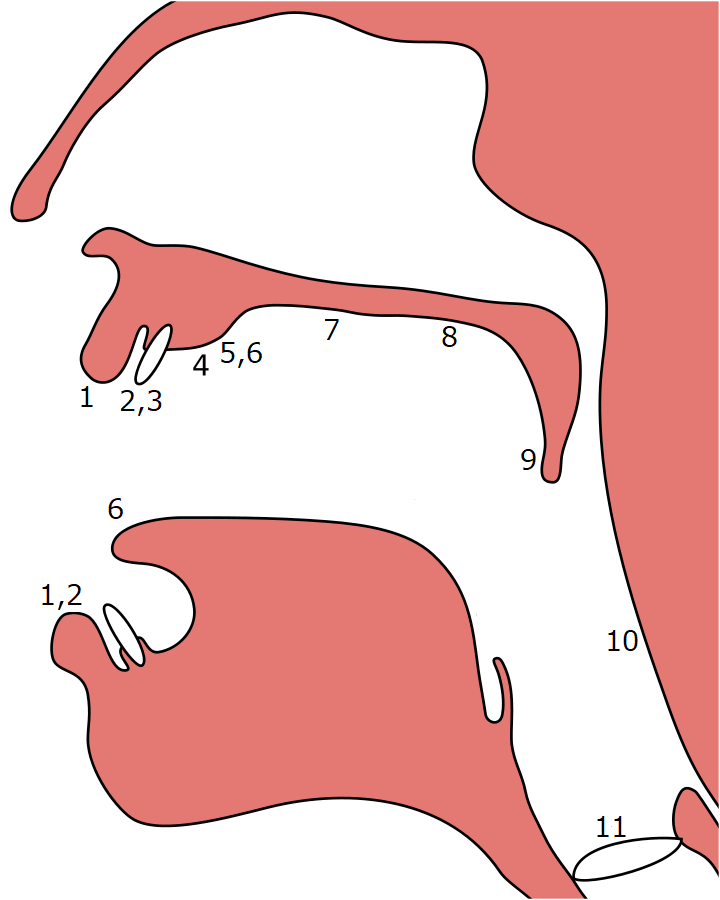How would you teach a foreigner how to pronounce your native language?
Personally, in English class, I learned that for the letter r, the tongue does not touch anywhere in the mouth, but for the letter l, the tongue touches the upper jaw. This is an accurate and clear explanation of the difference between the two. However, it is a poor explanation of the single sound “l” to say that “l” is the sound of the tongue being attached to somewhere in the mouth. Of course, there are many other tongue-attached sounds.
So how many elements are necessary to explain a sound and what are they? In this article, we will introduce how to describe consonant sounds using the International Phonetic Alphabet.
目次
Pronunciation of consonants
The International Phonetic Alphabet describes consonants in terms of three components: voicedness, articulatory place, and articulatory manner.
The International Phonetic Alphabet was proposed by the International Phonetic Association in order to represent the world‘s languages in written form. The symbols include not only consonants but also vowels, accents, and intonation.
Voicedness
Voicedness is the characteristic of whether or not the vocal cords are vibrating.
- Voiced sound: sound with vocal cords vibration
- Voiceless sound: sound without vocal cords vibration
Articulatory place
The articulation place is the place where articulation occurs, that is, the place in the mouth which is narrowed or closed when the consonant is pronounced.

- Bilabial
- Labio-dental
- Dental
- Alveolar
- Post-Alveolar
- Retro-flex
- Palatal
- Velar
- Uvular
- Pharyngeal
- Glottal
- c.f. Alveolo-palatal
Articulatory manner
Articulation is a manner to articulate, that is, to narrow or close a certain point in the oral cavity. There are nine manners, listed below, including sounds that are not usually apparent in the Japanese language.
- Plosive: the vocal tract is completely closed at the point of articulation, and then opened all at once.
- Nasal: the oral cavity is completely closed at the articulation point and the exhalation is emitted from the nose.
- Trill: Tongue or other parts of the mouth vibrate at least twice at the point of articulation.
- Tap / Flap: the articulation point is lightly touched with the tongue once, and bounced.
- Fricative: the vocal tract is narrowed at the articulatory place and the exhalation is emitted through the space
- Lateral fricative: the center of the oral cavity is closed with the tongue and exhalation is emitted through the side spaces.
- Approximant: the upper and lower articulators are placed close together, and the vocal sound is resonated in the narrow space.
- Lateral approximant: the center of the oral cavity is closed with the tongue and the vocal sound is resonated in the narrow space.
- Affricate: the vocal tract is completely closed at the articulatory place and then opened and exhalation is emitted through the space.
The vocal tract is the cavity where the sound produced at the sound source is filtered.
Description method
The name of each sound is written in the order of voicedness, articulatory place, and articulatory manner.
For example, a consonant in the K line that is voiceless, velar palatal, and plosive (stop) would be written as “voiceless velar plosive (stop)”.
When two or more articulations occur at the same time and to the same degree in two or more articulators, two articulation points should be described. For example, the /w/ sound, observed in “wood” is described as a “voiced bilabial velar approximant”.
Summary
In this article, we introduced how to describe the pronunciation of consonants using the International Phonetic Alphabet.
The pronunciation of consonants can be described in terms of three factors: voicedness, articulatory place, and articulatory manner.
- Voicedness: Vibration of the vocal cords
- Voiced sound
- Voiceless sound
- Articulatory place: Place where articulation (narrowing or closing) occurs
- Bilabial, Labio-dental, Dental, Alveolar, Post-Alveolar, Retro-flex, Palatal, Velar, Uvular, Pharyngeal, Glottal
- Articulatory manner: Way to articulate (narrow or close) sounds
- Plosive, Nasal, Trill, Tap / flap, Fricative, Lateral fricative, Approximant, Lateral approximant, Affricate
In future articles, we will show you how to describe vowel pronunciations. Please take a look at that as well.
References & Images
•Shawar, I. (2007, March 11). File:Places of articulation.svg – Wikimedia Commons. https://commons.wikimedia.org/wiki/File:Places_of_articulation.svg?uselang=ja
•International Phonetic Association. (2015). The International phonetic Alphabet (revised to 2015) . https://www.internationalphoneticassociation.org/sites/default/files/IPA_Kiel_2015.pdf
•Toutios, A., Lingala, S. G., Vaz, C., Kim, J., Esling, J., Keating, P., Gordon, M., Byrd, D., Goldstein, L., Nayak, K., & Narayanan, S. (2019, January 17). span | the rtMRI IPA charts.
•公益財団法人日本国際教育支援協会. (2021, November 5). 日本語教育能力検定試験の出題範囲の移行について. http://www.jees.or.jp/jltct/pdf/R4syutsudai.pdf
•国際音声学会. (2003). 国際音声記号ガイドブック : 国際音声学会案内 (国際音声学会, 編.). (竹林滋, 神山孝夫, 訳.). 大修館書店.
•川原繁人. (2020). 三省堂(川原 2018). http://user.keio.ac.jp/~kawahara/sanseido.html

